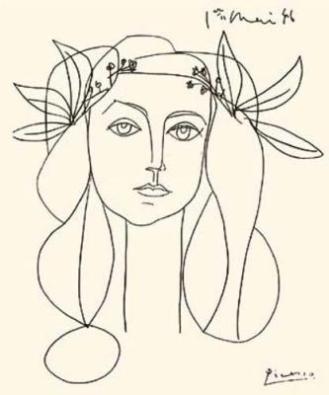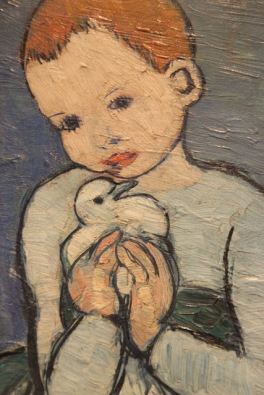Born in Málaga, Spain, in 1881, Pablo Picasso, became one of the greatest and most influential  artists of the 20th century and the creator (with Georges Braque) of Cubism. A Spanish expatriate painter, sculptor, printmaker, ceramicist and stage designer, Picasso was considered radical in his work. After a long prolific career, he died on April 8, 1973, in Mougins, France. The enormous body of Picasso’s work remains, however, and the legend lives on—a tribute to the vitality of the “disquieting” Spaniard with the “sombrepiercing” eyes who superstitiously believed that work would keep him alive. For nearly 80 of his 91 years, Picasso devoted himself to an artistic production that contributed significantly to—and paralleled the entire development of—modern art in the 20th century.
artists of the 20th century and the creator (with Georges Braque) of Cubism. A Spanish expatriate painter, sculptor, printmaker, ceramicist and stage designer, Picasso was considered radical in his work. After a long prolific career, he died on April 8, 1973, in Mougins, France. The enormous body of Picasso’s work remains, however, and the legend lives on—a tribute to the vitality of the “disquieting” Spaniard with the “sombrepiercing” eyes who superstitiously believed that work would keep him alive. For nearly 80 of his 91 years, Picasso devoted himself to an artistic production that contributed significantly to—and paralleled the entire development of—modern art in the 20th century.
From Wikipedia, the free encyclopedia
- 1 Early life
- 2 Career beginnings
- 3 Modern art transformed
- 4 Political views
- 5 Style and technique
- 6 Artistic legacy
Style and technique
From Wikipedia, the free encyclopedia
was exceptionally prolific throughout his long lifetime. The total number of artworks he produced has been estimated at 50,000, comprising 1,885 paintings; 1,228 sculptures; 2,880 ceramics, roughly 12,000 drawings, many thousands of prints, and numerous tapestries and rugs.[61]
The medium in which Picasso made his most important contribution was painting.[62] In his paintings, Picasso used color as an expressive element, but relied on drawing rather than subtleties of color to create form and space.[62] He sometimes added sand to his paint to vary its texture. A nanoprobe of Picasso’s The Red Armchair (1931) by physicists at  Argonne National Laboratory in 2012 confirmed art historians’ belief that Picasso used common house paint in many of his paintings.[63] Much of his painting was done at night by artificial light.
Argonne National Laboratory in 2012 confirmed art historians’ belief that Picasso used common house paint in many of his paintings.[63] Much of his painting was done at night by artificial light.
Picasso’s early sculptures were carved from wood or modeled in wax or clay, but from 1909 to 1928 Picasso abandoned modeling and instead made sculptural constructions using diverse materials.[62] An example is Guitar (1912), a relief construction made of sheet metal and wire that Jane Fluegel terms a “three-dimensional planar counterpart of Cubist painting” that marks a “revolutionary departure from the traditional approaches, modeling and carving”.[64]
From the beginning of his career, Picasso displayed an interest in subject matter of every kind,[65] and demonstrated a great stylistic versatility that enabled him to work in several styles at once. For example, his paintings of 1917 included the pointillist Woman with a Mantilla, the Cubist Figure in an Armchair, and the naturalistic Harlequin (all in the Museu Picasso, Barcelona). In 1919, he made a number of drawings from postcards and photographs that reflect his interest in the stylistic conventions and static character  of posed photographs.[66] In 1921 he simultaneously painted several large neoclassical paintings and two versions of the Cubist composition Three Musicians (Museum of Modern Art, New York; Philadelphia Museum of Art).[33] In an interview published in 1923, Picasso said, “The several manners I have used in my art must not be considered as an evolution, or as steps towards an unknown ideal of painting … If the subjects I have wanted to express have suggested different ways of expression I have never hesitated to adopt them.”[33]
of posed photographs.[66] In 1921 he simultaneously painted several large neoclassical paintings and two versions of the Cubist composition Three Musicians (Museum of Modern Art, New York; Philadelphia Museum of Art).[33] In an interview published in 1923, Picasso said, “The several manners I have used in my art must not be considered as an evolution, or as steps towards an unknown ideal of painting … If the subjects I have wanted to express have suggested different ways of expression I have never hesitated to adopt them.”[33]
Although his Cubist works approach abstraction, Picasso never relinquished the objects of the real world as subject  matter. Prominent in his Cubist paintings are forms easily recognized as guitars, violins, and bottles.[67] When Picasso depicted complex narrative scenes it was usually in prints, drawings, and small-scale works; Guernica (1937) is one of his few large narrative paintings.[66]
matter. Prominent in his Cubist paintings are forms easily recognized as guitars, violins, and bottles.[67] When Picasso depicted complex narrative scenes it was usually in prints, drawings, and small-scale works; Guernica (1937) is one of his few large narrative paintings.[66]
Picasso painted mostly from  imagination or memory. According to William Rubin, Picasso “could only make great art from subjects that truly involved him …. Unlike Matisse, Picasso had eschewed models virtually all his mature life, preferring to paint individuals whose lives had both impinged on, and had real significance for, his own.”[68] The art critic Arthur Danto said Picasso’s work constitutes a “vast pictorial autobiography” that provides some basis for the popular conception that “Picasso invented a new style each time he fell in love with a new woman”.[68] The autobiographical nature of Picasso’s art is reinforced by his habit of dating his works, often to the day. He explained: “I want to leave to posterity a documentation that will be as complete as possible. That’s why I put a date on everything I do.”[68]
imagination or memory. According to William Rubin, Picasso “could only make great art from subjects that truly involved him …. Unlike Matisse, Picasso had eschewed models virtually all his mature life, preferring to paint individuals whose lives had both impinged on, and had real significance for, his own.”[68] The art critic Arthur Danto said Picasso’s work constitutes a “vast pictorial autobiography” that provides some basis for the popular conception that “Picasso invented a new style each time he fell in love with a new woman”.[68] The autobiographical nature of Picasso’s art is reinforced by his habit of dating his works, often to the day. He explained: “I want to leave to posterity a documentation that will be as complete as possible. That’s why I put a date on everything I do.”[68]
